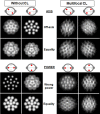Retinal Image Simulation of Subjective Refraction Techniques
- PMID: 26938648
- PMCID: PMC4777443
- DOI: 10.1371/journal.pone.0150204
Retinal Image Simulation of Subjective Refraction Techniques
Abstract
Refraction techniques make it possible to determine the most appropriate sphero-cylindrical lens prescription to achieve the best possible visual quality. Among these techniques, subjective refraction (i.e., patient's response-guided refraction) is the most commonly used approach. In this context, this paper's main goal is to present a simulation software that implements in a virtual manner various subjective-refraction techniques--including Jackson's Cross-Cylinder test (JCC)--relying all on the observation of computer-generated retinal images. This software has also been used to evaluate visual quality when the JCC test is performed in multifocal-contact-lens wearers. The results reveal this software's usefulness to simulate the retinal image quality that a particular visual compensation provides. Moreover, it can help to gain a deeper insight and to improve existing refraction techniques and it can be used for simulated training.
Conflict of interest statement
Figures













References
-
- Benjamin WL. Borish’s Clinical Refraction Oxford: Butterworth-Heinemann; 2006.
-
- Bennett RB. Clinical Visual Optics. Oxford: Butterworth-Heinemann; 1998.
-
- Michaels DM. Visual Optics and Refraction: A Clinical Approach St Louis: The CV Mosby Co; 1985.
-
- Collins MJ, Shaw A, Menkens E, Davis B, Frankli R. The effect of pupil size on subjective refraction with irregular cornea. Invest Ophthalmol Vis Sci. 2002;43:E-Abstract 2058.
Publication types
MeSH terms
LinkOut - more resources
Full Text Sources
Other Literature Sources
Medical

